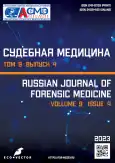Individual age determination based on computed tomography knee analysis using artificial neural networks and computer vision: Preliminary results
- Authors: Zolotenkov D.D.1, Trufanov M.I.2, Solodovnikov V.I.2
-
Affiliations:
- I.M. Sechenov First Moscow State Medical University (Sechenov University)
- Design Information Technologies Center Russian Academy of Sciences
- Issue: Vol 9, No 4 (2023)
- Pages: 403-412
- Section: Original study articles
- URL: https://journals.rcsi.science/2411-8729/article/view/251334
- DOI: https://doi.org/10.17816/fm11915
- ID: 251334
Cite item
Full Text
Abstract
BACKGROUND: Currently, studies have focused on the modernization of existing methods of forensic age assessment (bone and skeletal) through the active use of modern methods of medical imaging (e.g., computed tomography) and artificial intelligence for their analysis. This approach enables the creation of new methods for assessing biological age, which is characterized by increased accuracy and reproducibility.
AIM: To develop and test an algorithm for predicting the biological age of an individual based on computed tomography analysis of the knee joint using artificial neural networks and computer vision.
MATERIALS AND METHODS: This observational retrospective transverse (one time) study analyzed computed tomography scans (334) of the knee joint performed in the Departments of Radiation Diagnostics of the Priorov Central Institute for Trauma and Orthopedics, Vreden National Medical Center for Traumatology and Orthopedics, between 2018 and 2021. The study enrolled persons of both sexes aged 13–45 years. Cases of developmental abnormalities, knee injuries, signs of general connective tissue pathology were excluded. Research methods include the use of intelligent information technologies (a formalized set of mathematical and software solutions).
RESULTS: Based on the experiments conducted, an algorithm for assessing age according to the computed tomography scans of the knee joint has been developed. The main components of the developed system are as follows: a preprocessing module, an intelligent computing core, a data analysis module, a three-dimensional reconstruction module, a property extraction module, and a final age assessment module. The essence of the proposed method is the simultaneous use of artificial neural networks and clearly formalized mathematical procedures for calculating the properties of the epiphyseal line. To obtain the results and conduct primary experimental studies that confirmed the feasibility, correctness, and operability of the method, software using the YOLOv5 neural network was developed. The result of the error matrix analysis after training shows a probability of correct recognition of the order of 80%. Verification of experimental studies was performed on 46 cases. At present, the age estimation error is approximately 1 year for children and adolescents.
CONCLUSIONS: The experimental results have confirmed the adequacy of the age estimates obtained to the actual age of the individual and, consequently, the applicability of the proposed method in forensic medical institutions. The proposed method is currently implemented as a set of software components with subsequent manual integration of automatically calculated data. The plan was to supplement the database of computed tomography images to increase the training sample and the accuracy of age prediction.
Full Text
##article.viewOnOriginalSite##About the authors
Dmitry D. Zolotenkov
I.M. Sechenov First Moscow State Medical University (Sechenov University)
Author for correspondence.
Email: Zolotenkovaspir@mail.ru
ORCID iD: 0000-0002-1224-1077
SPIN-code: 1352-8848
Russian Federation, Moscow
Maksim I. Trufanov
Design Information Technologies Center Russian Academy of Sciences
Email: temp1202@mail.ru
ORCID iD: 0000-0001-7269-8741
SPIN-code: 1519-0717
Cand. Sci. (Engin.)
Russian Federation, OdintsovoVladimir I. Solodovnikov
Design Information Technologies Center Russian Academy of Sciences
Email: v_solodovnikov@hotmail.com
ORCID iD: 0000-0001-5533-214X
SPIN-code: 5418-6554
Cand. Sci. (Engin.)
Russian Federation, OdintsovoReferences
- AGFAD (2018) Stellungnahme: Forensische altersdiagnostik bei unbegleiteten minderjährigen flüchtlingen. Arbeitsgemeinschaft für forensische altersdiagnostik. Available from: https://www.dgrm.de/institute/deutschland/institut-essen/news-essen/stel.... Accessed: 15.5.2020.
- Schmeling A, Grundmann C, Fuhrmann A, et al. Criteria for age estimation in living individuals. Int J Legal Med. 2008;122(6):457–460. doi: 10.1007/s00414-008-0254-2
- Schmeling A, Dettmeyer R, Rudolf E, et al. Forensic age estimation: Methods, certainty, and the law. Dtsch Arztebl Int. 2016;113(4):44–50. doi: 10.3238/arztebl.2016.0044
- Lopatin O, Barszcz M, Bolechala F, Wozniak KJ. All rights reserved. The fusion of ossification centers: A comparative review of radiographic and other imaging modalities of age assessment in living groups of children, adolescents, and young adults. Leg Med (Tokyo). 2023;(61):102185. doi: 10.1016/j.legalmed.2022.102185
- Sobh ZK, Mohamed AS. A computed tomographic analysis of spheno-occipital synchondrosis ossification for age estimation in a sample of Egyptians. Am J Forensic Med Pathol. 2021;42(3):235–242. doi: 10.1097/PAF.0000000000000645
- Fan F, Zhang K, Peng Z, et al. Forensic age estimation of living persons from the knee: Comparison of MRI with radiographs. Forensic Sci Int. 2016;(268):145–150. doi: 10.1016/j.forsciint.2016.10.002
- Wittschieber D, Schulz R, Vieth V, et al. Influence of the examiner’s qualification and sources of error during stage determination of the medial clavicular epiphysis by means of computed tomography. Int J Legal Med. 2014;128(1):183–191. doi: 10.1007/s00414-013-0932-6
- Pröve PL, Jopp-van Well E, Stanczus B, et al. Automated segmentation of the knee for age assessment in 3D MR images using convolutional neural networks. Int J Legal Med. 2019;133(4):1191–1205. doi: 10.1007/s00414-018-1953-y
- Mauer MA, Well EJ, Herrmann J, et al. Automated age estimation of young individuals based on 3D knee MRI using deep learning. Int J Legal Med. 2021;135(2):649–663. doi: 10.1007/s00414-020-02465-z
- Dallora AL, Anderberg P, Kvist O, et al. Bone age assessment with various machine learning techniques: A systematic literature review and meta-analysis. PLoS One. 2019;14(7):e0220242. doi: 10.1371/journal.pone.0220242
- Arji G, Safdari R, Rezaeizadeh H, et al. A systematic literature review and classification of knowledge discovery in traditional medicine. Comp Methods Programs Biomed. 2019;(168):39–57. doi: 10.1016/j.cmpb.2018.10.017
- Zolotenkova GV, Rogachev AI, Pigolkin YI, et al. Age сlassification in forensic medicine using machine learning techniques. Modern Technol Med. 2022;14(1):15–24. doi: 10.17691/stm2022.14.1.02
- Ferrante L, Skrami E, Gesuita R, Cameriere R. Bayesian calibration for forensic age estimation. Statistics Med. 2015;34(10):1779–1790. doi: 10.1002/sim.6448
- Mauer MA, Well EJ, Herrmann J, et al. Automated age estimation of young individuals based on 3D knee MRI using deep learning. Int J Legal Med. 2021;135(2):649–663. doi: 10.1007/s00414-020-02465-z
- Dallora AL, Berglund JS, Brogren M, et al. Age assessment of youth and young adults using magnetic resonance imaging of the knee: A deep learning approach. JMIR Med Inform. 2019;7(4):e16291. doi: 10.2196/16291
Supplementary files











